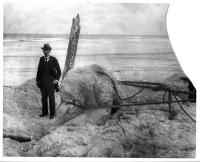
The St. Augustine Monster,1897, by DeWitt Webb, photograph
In most cases, no one ever manages to find the carcass of a dead sea serpent or lake monster washed up on a beach. The one big, literal and figurative, exception are the”globsters,” massive carcasses which have been washing shore for more than a century. A globster is usually defined as a large, unidentified organic mass that washes up on the shoreline of an ocean or other body of water. In many cases they have no eyes, head, or identifiable bone structure. One such globster was the “St. Augustine Monster” which washed ashore on the coast near St. Augustine, Florida, in 1896. Partially covered by sand, the exposed portion was over 18 feet long and 7 feet wide. It was estimated to weigh over five tons. The mass had no apparent bones but appeared to have tentacles, so it was originally identified as a new type of giant octopus.
Globsters have continued to wash ashore. In August 1960, an unidentified carcass washed ashore near the Interview River in western Tasmania. A local newspaper described it as: “About 20ft. long, 18ft. wide and about 4 1/2 ft. thick, with an estimated weight of between five and 10 tons. … There was no appearance of eyes or other organs.” In May 1988, a globster washed ashore in Mangrove Bay, Bermuda. It was soon nick-named the Bermuda Blob. The carcass was about 8 feet long, described the carcass as “2 1/2 to 3 feet thick … very white and fibrous, with five ‘arms or legs,’ rather like a disfigured star.” It had no bones, cartilage, visible openings, or odor.” Another, similar blob, floated ashore on St. Bernard’s, Fortune Bay, Newfoundland on 2 August 2001. An even larger example of a similar blob was found in Chile in 2003. It weighed 13 tonnes and measured 39 ft across and was also initially identified as a giant octopus.
Sadly for those who dream of discovering the Octopus giganteus or some other mysterious beast, the blobs have generally been determined to be decomposed whales, usually sperm whales. It appears that at a certain point of decomposition, the whale bones detach from the carcass and sink, leaving large masses of blubber held together by thick layers of collagen to float ashore.
Not all unidentified carcasses are so blobbish. A number have well defined skeletons and have been identified as plesiosaurs. As was the case with the blobs, however, most of the “plesiosaur” carcasses have were later identified as more conventional marine life, in these cases decomposing basking sharks.

Now with DNA, they can figure out what they are and where they came from, (different parts or areas) of the ocean.